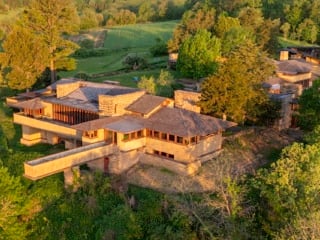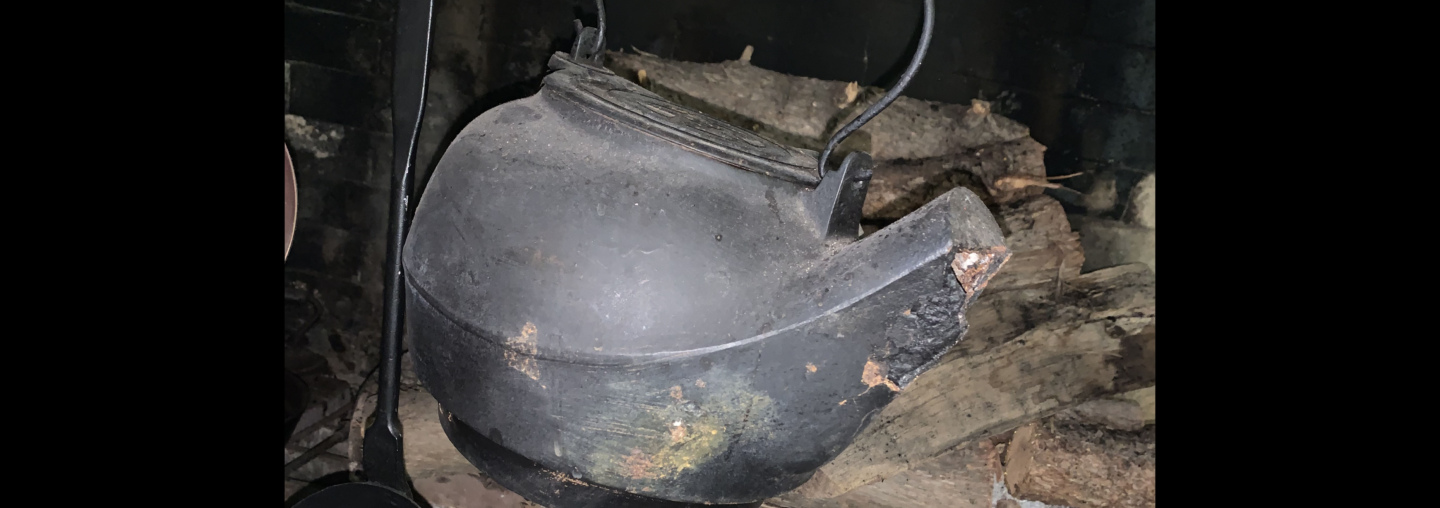
Willey House Stories Part 22: Calling the Kettle Back—Chapter 4: A Heritage of Cooking Fires
Steve Sikora | Jan 27, 2023
In this seven-chapter subseries of the Willey House Stories, Steve Sikora reflects on Frank Lloyd Wright’s fireplaces, their purpose and meaning—and the search for one missing kettle. Subsequent chapters will follow over the next few weeks.
My curiosity about a kettle led me to better understand how one might be used in a fireplace.
Some time after our mastery of fire, came humankind’s ability to cook food with it. Initially, game was rapidly roasted, directly over flame on a stick. Next, came the more controlled methods of placing meats over hot stones, wrapped in clay and dropped into the fire or laid inside dugout earth ovens, lined with coals, to slowly roast them. These forms of slow cooking allowed the collagen in connective tissues to break down, which made meat easier to chew and more digestible. The adoption of boiled water for cooking appeared around 30,000 years ago. It was first accomplished in found natural vessels such as turtle shells, hollow bamboo trunks and dried gourds. Later, woven baskets were widely employed and eventually fired clay pots became the culinary standard worldwide. The smelting of copper began around 6,000 BCE in the Fertile Crescent. But durable metals did not exist until some time later in the Bronze Age, spanning 3300-1200 BCE. Iron casting, a relatively recent development, originated in China around 1000 BCE and the advancement of the sand molding process that followed, around 645 BCE, made it possible to pour cast iron cookware. For much of our existence as a species, or at least 1.2 million years of it, humans have cooked with fire. So naturally, we continue to associate fire and the fireplace with nourishment. Some of Frank Lloyd Wright’s fireplaces, particularly those with cranes, seem to overtly reinforce our ancestral connection between fire and food.
The fireplace: a source of nourishment
As previously discussed, cranes are the swiveling armatures that cooking pots hang from inside a fireplace. To examine Wright’s incorporation of fireplace arms in his homes, it’s useful to revisit American history. Historical context helps to justify
his inclusion of at least one fireplace in every home, particularly if it featured a nod to some cooking apparatus.
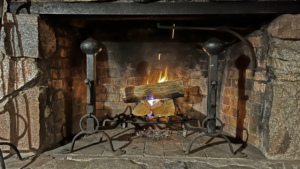
A simple pot crane inside a 1915 Arts & Crafts fireplace. Credit: Steve Sikora
After all cooking over an open flame is how Colonial meals were prepared. Many of Wright’s fireplaces hint at food preparation, even if his fireplaces were seldom if ever located in kitchens—dining rooms and alcoves, yes, kitchens no.
“Cooking is one of the strongest ceremonies for life. When recipes are put together, the kitchen is a chemical laboratory involving air, fire, water and the earth. This is what gives value to humans and elevates their spiritual qualities. If you take a frozen box and stick it in the microwave, you become connected to the factory.”
– Laura Esquivel—author, Like Water for Chocolate
We assume that modern food prep has always occurred inside the house. But as Elizabeth Collins Cromley explains in her book The Food Axis, particularly in mild climates and warm seasons cooking was done outdoors or in freestanding buildings. The reasons for this were the byproduct of excess heat during warm weather seasons and the reduction of cooking odors. However, as times changed more cooking functions were gradually brought indoors. As Cromley wrote, “Today’s kitchen is not only inside the dwelling but it is commonly characterized as the ‘heart of the home,’” a sentiment often echoed by Wright. He described his organic buildings as organisms and considered the fireplace to be the literal, beating heart of the house, a spiritual center, and a communal hub.
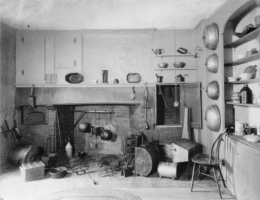
A Colonial era fireplace was purpose-designed with specific places in the masonry to cook, grill, bake and possibly smoke meats. Credit: Library of Congress, Public domain, via Wikimedia Commons
True, cooking fireplaces were purpose-built and highly specialized. It required the attention of a cook with a highly developed skill set to manage one. According to Cromley, “Colonial households in New England built fires for cooking in the hall fireplace… The decision to put the cooking fire inside the house gave the resident a double benefit from the fire—cooked food and heat to keep themselves warm.” A cooking fireplace was designed to serve multiple simultaneous functions, “Preparing food in a fireplace requires various kinds of heat for different kinds of cooking. Roasting and grilling both require an intense heat source over which the food is held on a rack, spit, or other device and cooked by direct exposure to the fire.
Baking requires dry heat in a closed container while simmering and boiling use a water-based liquid in an open or lidded container. Frying is done in a pan in which the food is cooked in heated fat. All of these cooking methods could be achieved in a cooking fireplace by a skilled cook using 2 or 3 different fires, but additional equipment would help.”
“A house is not a home unless it contains food and fire for the mind as well as the body”
– Benjamin Franklin
Wright’s romantically hobbed hearths don’t come close to fitting the multi-functional parameters, of the simplest, purpose-built, Colonial cooking fireplace. Really, his sole nod to food preparation is the inclusion of an occasional fireplace crane, also known as chimney cranes or pot cranes. Cranes were a common feature of 18th and 19th century fireplaces, only occasionally seen in the early 20th. Not that a crane would be without utility today, but a simple fireplace crane is a mere wink at a fully operational cooking fireplace. Crane arms exist in the hearths of numerous Wright houses from his mid-career forward. Most famous of course is the living room fireplace at Fallingwater, 1935, but built examples exist at Taliesin III, 1925, Taliesin West, 1937, Willey, 1933 and Neils, 1951 both in Minneapolis, Wingspread in Racine, 1939, Samara in West Lafayette, 1954, to name a few.
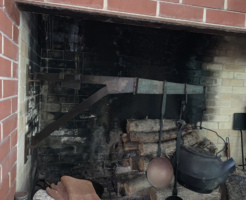
The fireplace crane in the Samara fireplace hinges at the wall and also at a knuckle midway down the length of the arm. Credit: Linda Eales
Restoration professional and master craftsman, Stafford Norris added several unbuilt project houses to the list of Wright homes with crane and kettle designs, again from the same period: the Royal Jurgensen House, in Evanston. IL, 1938, the George McCallum House of Northampton, Massachusetts, 1938, the Lewis N. Bell House, Los Angeles, 1939, the Charles E. Bell House of East St. Louis, 1947, and the second V.C. Morris House, San Francisco, 1954. The original fireplace design for the 1948 Mr. and Mrs. Jack Lamberson House in Oskaloosa, Iowa featured a crane with large suspended fire basket in place of a kettle. And the Ellis and Alice Feiman House, Canton, Ohio, 1955 was designed with a crane and globe kettle. It is unclear if those features were ever completed. Each of Wright’s kettle and crane designs is somewhat unique. Each has an integrated kettle or simply a crane capable of holding one. Wright gave us cranes aplenty, yes. Yet it seems none of them are entirely practical for serious cooking, as homeowners will attest.
The breathtaking, Cherokee Red enameled, Fallingwater cauldron, which ingeniously pivots back into a niche in the stonework, is equipped with a spigot at its base, ostensibly to tap mulling wine. Anecdotal evidence suggests that spiced wine was indeed mulled or warmed at Fallingwater. Cook, Elsie Henderson makes mention of it in her 2008 memoir. During a 1937 housewarming party for the locals, she quotes caretaker, Earl Friend who remembered, “the day they had hot wine in the big kettle hanging in the fireplace. ‘Some of these country women thought it was hot tea, so they got it, and then they didn’t know what to do with it!’” Another story suggests the mass of this kettle was so great that even a prolonged blaze never quite brought it up to the desired temperature so the wine was heated in the kitchen and only served from the kettle. On the subject of the cauldron, Scott Perkins, Director of Preservation and Collections at Fallingwater concluded, “I cannot imagine it was used except for very special occasions when the host wanted to make an impression.”
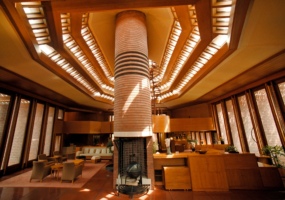
The west fireplace takes center stage in the expansive great room of the Herbert Johnson House, Wingspread. Credit: Mark Hertzberg
A different but equally goliath cauldron exists at Wingspread, the sprawling pinwheel residence Wright designed for Herbert Johnson. The house is now a conference center. The iron orb of the west fireplace flaunts a removable dome lid to complete its geometrically perfect form. My perception has always been that the spheroid kettle seemed so out of proportion with the fire grate below it, that the size of fire one could kindle was unlikely to heat the iron kettle before guests tired and went home. But author and architect Jonathan Lipman reports otherwise. He said that Hib Johnson and family members did use the colossal iron kettle on occasion to mull cider.
The President of Wingspread, Marcus White says that in addition to the Johnson family’s use, the current chef at Wingspread has served from the kettle for special events, but never directly cooked in it. To facilitate its use, the Wingspread kettle is fitted with a stainless steel liner.
Even the impressive, black cauldron suspended from a crane in the drafting room fireplace at Taliesin, (originally placed in the 1953 Usonian Exhibition House, exhibited on the site of the Guggenheim, for the 60 Years of Living Architecture show), performed little more than a ceremonial purpose at Taliesin, according to Collections Coordinator, Kyle Dockery. A matching spheroid cauldron exists in the 1951 Henry and Freida Neils House in Minneapolis. Both iron kettles were cast at the Neils’ foundry, The Flour City Ornamental Iron Works. The daughter of Mr. and Mrs. Neils, Mary McGee shared many amusing anecdotes with us about her family home but never mentioned using the kettle. I wish now that I’d pressed her on the subject.
One other building in Wright’s oeuvre came equipped with a swiveling fireplace cooking apparatus, though minus a dedicated kettle. That is the 1945 Arnold Friedman Lodge in Pecos, New Mexico. In his drawings, Wright labeled it a “grille.” As in most every other aspect of this mountain vacation lodge, the fireplace is romantically monumental, rustic, and distinct. The hearth is decidedly tall, designed at six foot, but built closer to five. The firebox opening measures nine foot wide. The magnificent fireplace is indisputably central to the design of the lodge, from the monumental chimney stack rising above and supporting the roofline to the way the hearth anchors the building to the earth and commands the dramatic living space. Unlike any other Wright fireplace I know of, it was specified to have a metal fireback angled outward, spanning the full width of the fireplace and sloping forward, up to the smoke shelf. This radiant accommodation would help convey the heat generated by the fire outward to warm the capacious, tepee-ceilinged great room. Grandson, Randall Friedman, recalls that the pivoting grill feature was used only once, in an attempt to grill steaks over the fire. The ensuing mess insured that once was often enough. The height reduction in the hearth opening may have been an effort on the builder’s part to assure a proper draft was achieved in such an enormous fireplace, however, two of the other four fireplaces in the lodge are reported to be smoky when lit. Apparently, no intervention at the time of construction was attempted elsewhere.
Former Taliesin resident and Public Access Manager for TPI, Craig Jacobson recalled an incident, one fall in the mid-1990s when the senior fellowship mulled wine with cinnamon sticks and spices in the Taliesin drafting room cauldron. Apparently, they kept the concoction brewing for several days. His memories of the incident are made indelible by the fact that it was his job to clean the kettle in preparation, and then again later to scour out the dregs after students and fellows departed for Arizona.
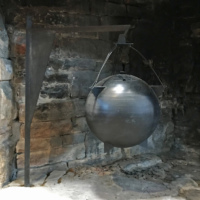
The globe-shaped kettle and buttressed crane in the drafting room at Hillside. Credit: Steve Sikora
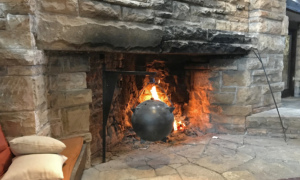
The Hillside drafting room fireplace with kettle ablaze. Credit: Steve Sikora
A recent resurgence in the popularity of wood-fire cookery provides us with another perspective on this question of fireplace cooking. All the requisite woodfire cooking skills are demonstrated in Paula Marcoux’s book, Cooking With Fire: From Roasting on a Spit to Baking in a Tannur, Rediscovered Techniques and Recipes That Capture the Flavors of Wood-Fired Cooking. Paula Marcoux is a food historian, archaeologist, cook, and bread-oven builder who resides in Plymouth, Massachusetts. She is an expert consultant on natural leavening, historic baking, and wood-fired cooking. I asked her opinion on Wright’s fireplaces.
Paula Marcoux mentioned she had once visited Wingspread and marveled at the elaborate, west fireplace. Like myself, she questioned how well the entire apparatus would perform. Aha, validation! I thought. My initial thesis focused on the improbability of Wright’s fireplaces serving as de facto kitchenettes. But after further inquiry and time to reflect, I came around to a more nuanced position. Paula Marcoux’s research inspired me. How could it not? After all, she spent the entirety of her book, Cooking With Fire illustrating how cooking can be done under a wide variety of primitive circumstances. Naturally, she favored demonstrating the possibilities of cooking rather than dwelling on the obstacles preventing it. Her book shifted my perspective on cooking in a Wright fireplace. I must now admit that with a positive attitude, it certainly can be done. Should it be done? Well, that’s another question.
Without hesitation, I can say that Wright’s fireplaces, were not engineered for the sort of practical cooking, daily accomplished in Early American homes. And there is one additional factor to consider. As Elizabeth Collins Cromley reminds us in the evolution of indoor cookery, that cooking fireplaces were “conceptually dirty and messy food preparation areas” that eventually needed to be separated from the “conceptually clean” public spaces of the house. Wright’s fireplaces were never situated in messy kitchen settings. Instead, they all reside in clean public spaces. The living room carpet is hardly a place to manage a red-hot, sloshing, cast iron vat, brimming with molten liquid.
Which brings us to the one notable exception to the cooking rule, Dr. John Christian of West Lafayette, Indiana. At his residence, Samara, he and his wife regularly used the fireplace for casual cooking. Director, Linda Eales was told by Dr. Christian that, “On Sunday nights they would cook beans and weenies in the kettle, pull out their Wright-designed TV trays and watch television.” Dr. Christian was a truly dedicated client with the demeanor and verve to live a rich and recklessly poetic life in his Wright-designed home. But he was an outlier.

The fireplace in the Hillside living room, built in 1902. Credit: Steve Sikora
Minerva Montooth, grand dame of Taliesin, reported to me that in her many decades of residency, before and after Wright’s passing, she had no recollection of the fireplaces ever being seriously employed for cooking. Although Minerva, a former apprentice, Jeremiah Kimber, and Craig Jacobson formerly of TPI, did all recount a single instance, when senior apprentices led by Tom Casey orchestrated a lamb roast on a makeshift spit, jury-rigged inside the capacious Hillside living room fireplace. I am told the delectability of the feast was only surpassed by the wretchedness of the oily residue it produced. The act was never repeated nor was it openly spoken of.
Based on questions of limited fireplace functionality and their location in the clean areas of the house, the only assumption to be made is that Wright’s fireplaces were never intended for any degree of dedicated cooking. I mean seriously.
But that brings me to a final point. Today’s kitchen is indisputably the communal hub of a home, a shift away from the living room as the recognized societal gathering place in Wright’s lifetime. So much a social center today that affluent homes sometimes have two kitchens; one for entertaining and another tucked away for the genuinely messy work of meal preparation. Ironically, these 21st century entertaining kitchens are often outfitted with a ceramic surround that recalls the arched openings of a colonial cooking fireplace.
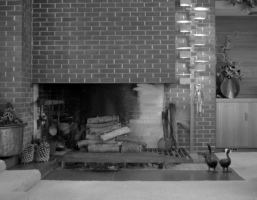
The fireplace in the Dr. John Christian House, Samara, built in 1954. Credit: Camille Fife
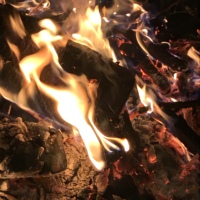
Credit: Steve Sikora
It’s all theater of course. But in a real sense, Wright’s fireplaces, supplied with cranes, essentially perform the function of an entertaining kitchen—in that they imply the idea of a meal prepared over the fire without necessitating the functionality of a full-fledged kitchen. Theater yes. But even appearances have purpose, as we shall see.
READ THE REST OF THE SERIES
Part 1: The Open Plan Kitchen
Part 2: Influencing Vernacular Architecture
Part 3: The Inner City Usonian
Part 4: A Bridge Too Far
Part 5: The Best of Clients
Part 6: Little Triggers
Part 7: Step Right Up
Part 8: A Rug Plan
Part 9: Hucksters, Charlatans, and Petty Criminals
Part 10: Lo on the Horizon
Part 11: Origins of Wright’s Cherokee Red
Part 12: One Thousand Words
Part 13: The Plow that Broke the Plains
Part 14: Separated at Birth
Part 15: Trading Drama for Poetry
Part 16: A Red By Any Other Name
Part 17: Roll Down to Levittown
Part 18: Cherokee Red The Rejoinder
Part 19: Nothing Lasts Forever
Part 20: The Struggle
Part 21: Giving What They Had to Give
Part 22: Calling the Kettle Back—Chapter 1: The Kettle
Part 22: Calling the Kettle Back—Chapter 2: The Crane
Part 22: Calling the Kettle Back—Chapter 3: Plagued By Fireplaces
Part 22: Calling the Kettle Back—Chapter 4: A Heritage of Cooking Fires
Part 22: Calling the Kettle Back—Chapter 5: Benefits of the Fireplace
Part 22: Calling the Kettle Back—Chapter 6: Transcendental Flame
Part 22: Calling the Kettle Back—Chapter 7: Repatriation


